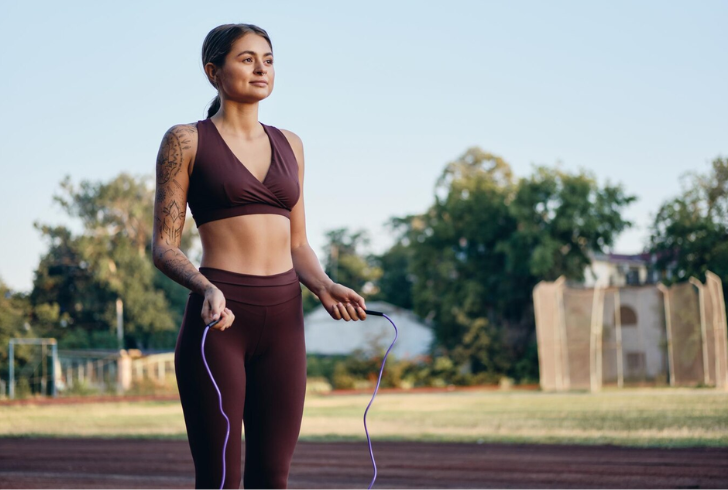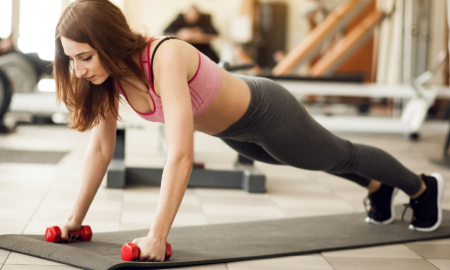
3 Beginner Skipping Workouts for Full-Body Fitness

If you’re on the hunt for an efficient, anywhere workout that torches calories and strengthens your entire body, it’s time to consider skipping. Yes, the humble skipping rope—something you might remember from childhood—can be an incredibly powerful fitness tool. While it may seem simple, skipping is a high-impact exercise that engages multiple muscle groups, improves cardiovascular health, and boosts coordination.
Celebrities like Jennifer Garner and Carrie Underwood have long sworn by skipping as part of their fitness routines. It’s no surprise, considering the many benefits it offers in such a short time.
Why Skipping Is More Than Just Fun
Skipping is not just a fun throwback to your school days. It’s an accessible and dynamic exercise that improves your cardiovascular fitness, balance, coordination, and even mental sharpness.
According to Lany Herman, CSCS, a certified strength and conditioning coach at Title Boxing Club, “Skipping is a complete workout that not only targets your lower body but also works your core, shoulders, and arms. It’s a total-body exercise that demands focus, making it a mental and physical challenge.”
Unlike many other exercises that require expensive equipment or a gym membership, all you need is a skipping rope and a little space. Plus, it’s beginner-friendly. Sure, it takes time to build your stamina, but consistency pays off—practicing even just three times a week will show improvements in your endurance and technique.
Perfect Your Skipping Form

Freepik | garetsvisual | Learn to skip properly before exercising to prevent injuries and improve results.
Before jumping into any workout, it’s important to master the basics of skipping form to prevent injury and get the most out of your session.
1. Position your rope – Stand on the rope, with feet together, and adjust it so the handles reach your armpits. Hold one handle in each hand.
2. Engage your core – Keep a neutral spine and avoid slouching. Focus on your posture as you move.
3. Proper jump technique – Jump lightly on the balls of your feet, about one to two inches off the ground. This minimizes impact on your joints and allows the rope to clear beneath your feet.
Getting comfortable with the movement can take time, but don’t be discouraged. Practice in front of a mirror to check your form and self-correct as you go.
Skipping Workouts for Beginners
Whether you’re a complete beginner or just looking to add some variety to your routine, here are three skipping workouts that target different aspects of fitness. Each one progressively challenges your stamina, agility, and coordination.
1. Skill & Speed Workout (5-7 minutes)
This short and sweet workout helps build rhythm and speed.
– Skip at a steady pace for 30 seconds.
– Ramp up the intensity, switching to fast skipping for 30 seconds while maintaining good form.
Rest for 30 seconds.
Repeat for 3–5 rounds.
2. Conditioning Intervals (9-15 minutes)
Perfect for enhancing endurance and strengthening your cardiovascular system.
– Skip at a steady pace for 30 seconds.
– Skip on your right leg for 15 seconds.
– Switch to the left leg for 15 seconds.
– Perform high knees for 30 seconds.
– Skip as fast as you can for 30 seconds.
Rest for 60 seconds.
Repeat for 3–5 rounds.
3. Agility, Conditioning, & Speed Workout (12-20 minutes)
A more challenging routine that combines all aspects of skipping for a full-body workout.
– Skip at a steady pace for 30 seconds.
– Skip at high speed for 30 seconds.
– Perform high knees for 30 seconds.
– Incorporate double-unders for 30 seconds.
– Skip at a steady pace for another 30 seconds.
– Finish with freestyle skipping for 30 seconds.
Rest for 60 seconds.
Repeat for 3–5 rounds.
Key Benefits of Skipping
Skipping isn’t just about burning calories. Here’s a closer look at some of the top benefits that make it worth including in your fitness regimen.
1. Boosts Cardiovascular Health

Freepik | freepic.diller | Regular skipping provides cardio that enhances heart health and reduces disease risks.
Since skipping elevates your heart rate, it provides an excellent cardio workout. Regular sessions improve heart health, reduce the risk of stroke and heart disease, and lower your risk for type 2 diabetes.
2. Enhances Coordination and Agility
As you skip, you’re constantly engaging multiple muscle groups, improving balance, footwork, and overall coordination. This can transfer to better performance in other sports and activities.
3. Builds Muscle and Tone
While skipping works your calves, hamstrings, quads, and glutes, it also engages your core and upper body. This full-body engagement helps you tone muscles, improve strength, and increase endurance.
4. Burns Calories Fast
A 15-minute skipping session can burn 200–300 calories, depending on intensity. It’s an efficient way to burn fat while improving strength, endurance, and cardiovascular health.
5. Portable and Convenient
The best part? You don’t need a gym membership or fancy equipment to get started. A skipping rope is compact, affordable, and easy to take with you on the go. Whether you’re at home, in the park, or traveling, a quick skipping workout is always within reach.
Whether you’re new to working out or just need something efficient, skipping is an excellent tool to get moving fast. It’s fun, low-cost, and effective. Try adding it to your fitness plan a few times a week—you’ll be amazed at the results.
Ready to grab that rope? Let’s go.
More inFitness
-
`
How Upcycled Beauty Ingredients Are Reshaping the Industry’s Future
The beauty industry is going through a big shift — and it’s not just about trends. As waste problems grow and...
July 17, 2025 -
`
A Look Inside Faith Kipyegon’s Groundbreaking Mile Run in Paris
Last week in Paris, Faith Kipyegon returned to a place she knows well: Stade Sébastien Charléty. But this time, she wasn’t...
July 9, 2025 -
`
Dairy Is Making a Major Comeback — And Health Shoppers Are Loving It
Just a few years ago, dairy sat quietly in the back seat while plant-based alternatives took the spotlight. Now, it’s stepping...
July 4, 2025 -
`
Does Aging Cause Dental Problems?
Aging doesn’t automatically mean losing teeth or developing gum disease. In fact, older adults today are holding onto more of their...
June 25, 2025 -
`
How Upcycled Ingredients Are Shaping the Future of Cosmetics
What used to end up in bins or compost heaps is now finding a new life inside skincare bottles and beauty...
June 18, 2025 -
`
Rock Legend Rod Stewart Trains to Break Sprint Record at 80
Age isn’t slowing Rod Stewart down. Known worldwide for his legendary voice, stadium-filling tours, and timeless hits like “Maggie May”, the...
June 11, 2025 -
`
The Truth Behind Detox Diets – Health Boost or Risky Trend?
It’s hard to scroll through your feed without seeing someone sipping green juice with promises of instant energy, glowing skin, and...
June 3, 2025 -
`
Is Dr. Oz Fit to Lead Medicare?
The announcement of Dr. Mehmet Oz as President-elect Donald Trump’s pick to lead the Centers for Medicare and Medicaid Services (CMS)...
May 29, 2025 -
`
Are Beauty Dupes Worth the Hype?
Beauty fans are no strangers to the world of product swaps. Whether it’s a $10 concealer rivaling a luxury $50 one...
May 21, 2025















You must be logged in to post a comment Login